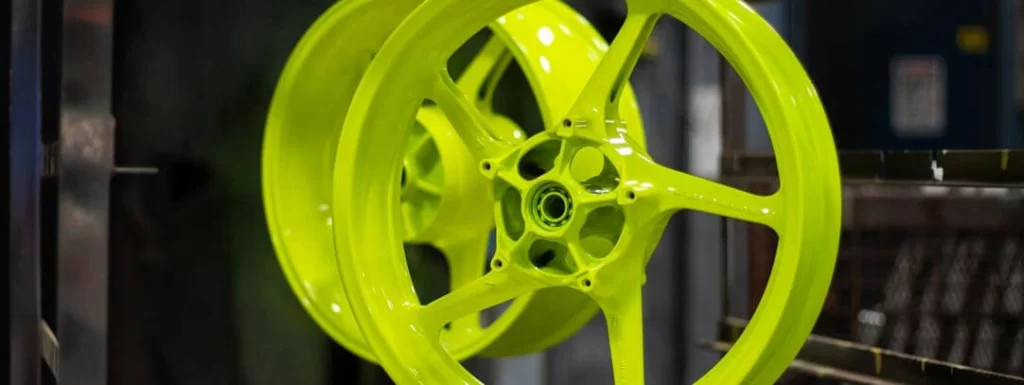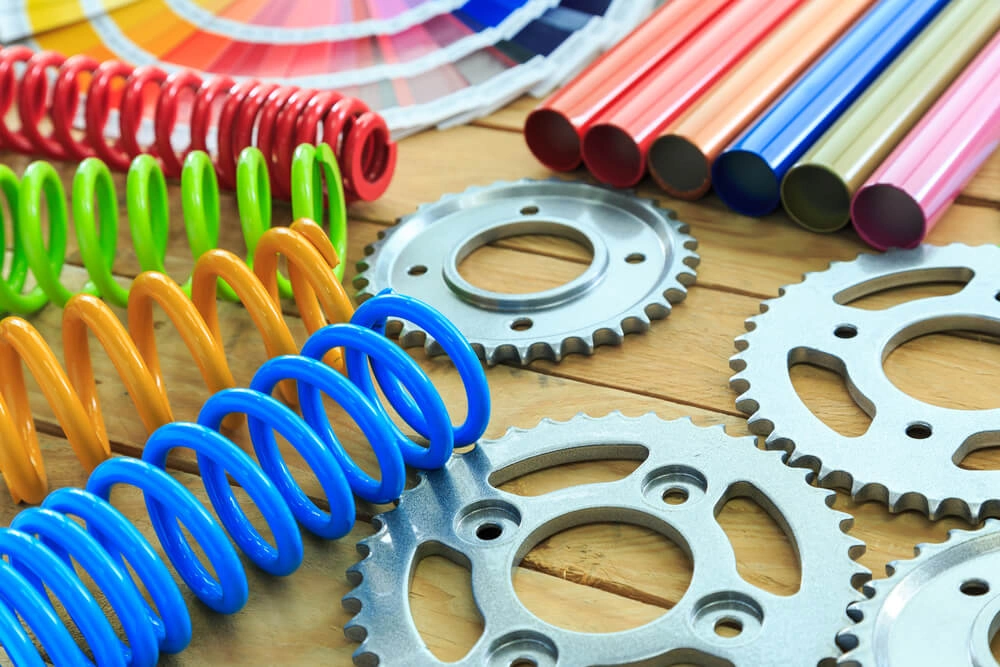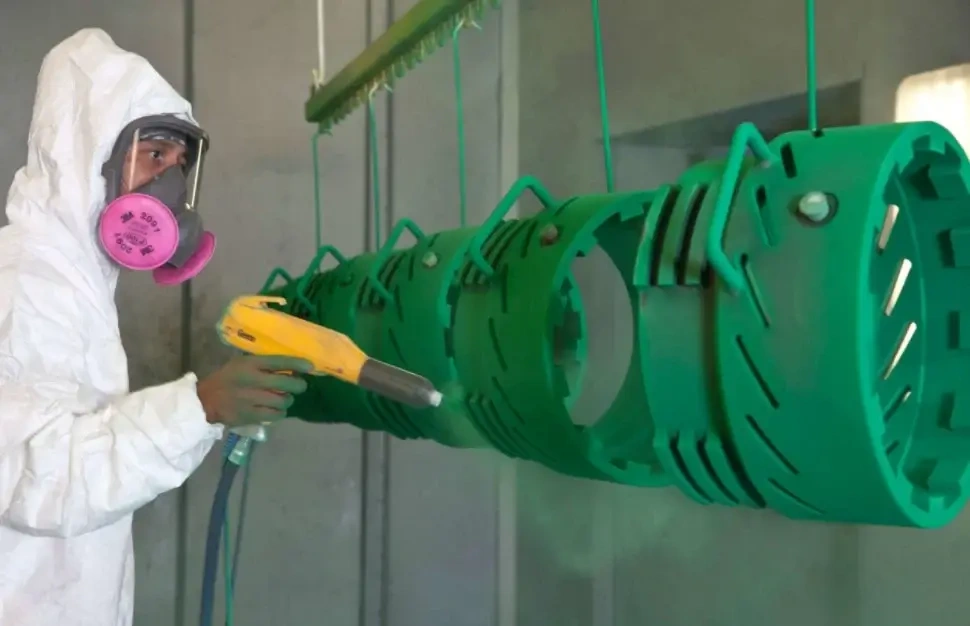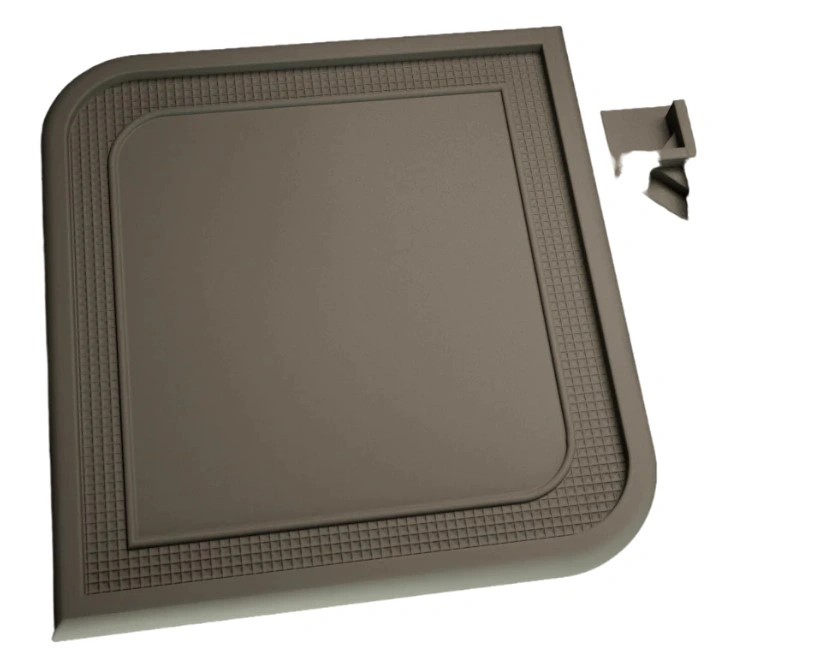
Powder coating is known as a durable and aesthetic finish in manufacturing, which comes in a variety of color options. Almost all metallic parts and some plastics and composites can be coated with a strong adhesive protective layer. The powder material depends on the types of powder coating; epoxy, polyester, and urethane-based coating are the most common to name.
The substrate metal parts(which can be CNC machined, aluminum extruded, cast, and sheet metal) are treated with either spraying or immersion in the powder pool, followed by thermal curing. The electrostatic deposition of powder and curing establish a permanent strong bond between the substrate surface and powder coating material.
In this article, we will discuss different powder coating finishes and their unique capabilities to help you choose which one best fits your parts.
Polyester Powder Coating
There are two types of polyester powder; Tri Glycidyl Iisocyanurate (TGIC) and urethane-based powders. The only difference is the difference in curing agents. The pigments can be blended with the powder for the desired aesthetic. Then, this charge is deposited by spraying a gun or dipping the parts in that.

Polyester powder coating
The thermal curing temperature range for polyester powder coating ranges from 150 to 200°C, depending on the formulation constituents of the powder. Meanwhile, the thickness can be 30 to 80 μm or more.
You can apply this coating for outdoor and exterior products, hardware, rumblings, furniture, power transmission lines, fencing and architectural items, and many more applications.
Advantages
- It strongly resists weather conditions over time, such as rain, sunlight, wind, moisture, corrosion, etc.
- The polyester coat establishes an excellent bond with the surface and protects it from wear and tear.
- Attractive aesthetic options, different pigments, and additives can be added in powder to customize the finish.
- It is one of the popular choices for aluminum powder coating, from automotive wheel covers to extruded aluminum parts.
Disadvantages
- It does not have high thermal stability.
- The higher-thickness polyester coats can cause the orange-peel-off effect.
Try Prolean Now!
Epoxy Powder Coating
Epoxy resin-based powders are among the power coating material types that offer high aesthetic, chemical resistance, and insulation properties. Mostly, aluminum and copper parts use an epoxy powder coating. Consequently, you can choose black, blue, gray, and various color options with it. Unlike polyester, epoxies are thermosets. So, the epoxy coating can handle more wear and tear.

Epoxy powder-coated parts
Often, it is blended with polyester and other thermoplastic power along with the additives for hybrid powder coating of epoxy-polyester. Subsequently, the hot charge can be applied through both dipping in the powder and direct spraying on the surface. The curing range is approximately 100 to 140 °C. The epoxy types of powder coating are used in applications requiring both aesthetics and protection from environments and chemicals. For example, pipes, consumer goods, medical furniture, automotive, aerospace parts, etc.
Advantages
- The epoxy coat offers good electrical insulation properties for wires and cables.
- Good chemical resistance ( solvents, soft acids, bases, etc) and withstands moisture and water over time.
- The smooth surface finish of epoxy adds high aesthetic value to the product and components.
- Possible to treat any complex shapes uniformly
- Good lubrication properties
Disadvantages
- The epoxy-based powders are not suitable for UV exposure.
- Appearances tend to fade away over time.
Nylon Powder Coating (Nylon 11 & 12)
These powder coat finish types offer impact strength, wear resistance, corrosion resistance, and other various physical and chemical properties. The typical coat thickness is 0. 075 mm to 0. 5 mm. Mostly spraying guns are used to apply the charge of nylon powder, mixed with curing agents and pigments. Consequently, the curing temperatures are approximately between 180 to 250 °C.

Nylon powder coating
Nylon coatings are beneficial for medical equipment components, industrial plant parts, valves, piping, dishwasher parts, racks in factories, and some food & medical-grade applications.
Advantages
- The high chemical inertness of nylon powders protects the parts from corrosion.
- Although performance is relatively lower than other powers, it offers a good balance of cost and durability.
- Nylon powder coating can maintain its functionality at elevated temperatures, sometimes more than 200 °C.
- The nylon powder coating surfaces provide a low coefficient of friction. So, it shows good lubrication properties.
Disadvantages
- It has a low UV-resistance capability
- Less color options with the nylon powder coat finish types (both Nylon 11 and Nylon 12)
- The control process might be challenging due to high-temperature curing.
Epoxy-Polyester Hybrid Powder Coating
The mix of epoxy and polyester powders strongly bonds with the material. The combined properties ease the coating process and enhance corrosion resistance, hardness, aesthetic, and chemical inertness. The final properties of the coated layer depend on the ratio of polyester and epoxy in the powder. For example, if epoxy is in a higher amount, it might more act as an epoxy finish. A typical ratio is 2: 3 ( Epoxy: Polyester) for most of the applications.

Polyester epoxy hybrid coating
Epoxy-polyester powder coating has flexible curing in terms of curing agents and control of parameters like temperature range and curing agents. Furniture, extinguishers, stoves, household items, electronics & telecommunication components, and other various items use the hybrid powder for a combination of functionality and aesthetics.
Advantages
- Epoxy-polymer powder is a durable finish that does not crack over time
- The hybrid coating offers better weather resistance than standard epoxy powders
- Good protection from chemical and corrosion
Disadvantages
- The coating provides limited UV exposure resistance, it tends to fade away after regular interaction with sunlight. So, it is not suitable for outdoor items.
- Inaccurate ratios of polyester and epoxy can significantly alter the desired specifications.
Try Prolean Now!
How to Choose the Right Powder Coating Type?
As there are different types of powder coating materials, it might confuse which one to choose for our parts. Well, it depends on many factors such as substrate material ( parts needed to be powder coated ), desired thickness, purpose of coating, required performance, cost, etc.
- Work Material Type
Adhesion and other interactions between powder coating materials and surface depend on the substrate material. Almost all types of powder coating are compatible with metal and alloys, whereas you might need to compare the adhesion and other compatibility for plastic and rubber parts.
- Desired Surface Properties
Based on the purpose of coating, list the desired properties like hardness, smoothness ( Ra value), corrosion resistance, weather resistance, chemical exposure, etc. Then, choose the best fit among the possible powder coating material types. For example, epoxy powders are more suitable for high wear resistance. The polyester provides impact resistance and low-temperature curing.
- Aesthetic Requirements
Aesthetic requirements include texture and color appearance. Do your parts need matte or gloss texture? For high gloss, acrylic or polymers can be the possible options. On the other hand, the polyester-epoxy hybrid can provide an attractive matte finish.
- Application Environment
The consideration of application environments includes outdoor or indoor (UV-exposure), chemical exposure, water & moisture, and temperature fluctuation. Epoxies are better options for indoor applications, whereas polyesters and acrylics are ideal for outdoor applications.
- Industry Standards
Based on the particular industrial applications, they have different standards for quality control of surface finishing, ASTM, ISO, etc. These types of standards are more crucial in industries like medical, food processing, and aerospace.
Are Powder Coating Finishes Better than Anodizing?
Both of these finishing methods have numerous color options, but they are different techniques. The anodizing process is mainly used for aluminum, titanium, and a few other metals, whereas powder coating is applicable for a diverse range of materials.

Anodizing vs powder coating
The anodizing works by creating an oxide layer on the metal surface through an electrochemical reaction. This protective layer enhances corrosion resistance, and surface hardness, and provides a base for color dyes or coatings.
The table below outlines the key anodizing vs powder coating differences;
| Criteria | Anodizing | Powder Coating |
| Process | An electrochemical process that forms an oxide layer on metal surfaces. | The powder is electrostatically sprayed and cured with heat |
| Materials | Typically aluminum alloys | Metal, alloys, and some plastics & composites |
| Finish | A durable, corrosion-resistant, and integrated surface layer. | A protective coating with various textures and colors. |
| Durability | High resistance to corrosion, abrasion, and wear. | Strong corrosion resistance and impact protection. |
| Aesthetic Options | Limited to metallic finishes with dyeing options. | Wide variety of colors and finishes, including matte and gloss. |
Get Custom Surface Finishes with Our Powder Coating Services
Do you need custom powder coating finishes according to your requirements? At ProleanTech, we have polyester, epoxy, acrylic, hybrid, and other various types of powder coating. These powders can be applied to CNC machined, sheet metal, extruded, and die-casted parts. We also have post-processing facilities like sanding, bead blasting, deburring, grinding, etc. to prepare the parts for uniform coating.
We use both powder charge spraying and dipping in the powder tank based on the parts’ geometries, size, and other specifications. Our engineers closely work with you to understand the requirements and deliver the highest quality results!
Try Prolean Now!
Summing Up
Different types of powder coating have their unique offering for protection from the environment and aesthetics. Meanwhile, epoxy and polystyrene are two popular powder types. Epoxy coating is suitable for indoor and polyester for outdoor environments. The polystyrene-epoxy hybrid coating is another option that balances the surface toughness, aesthetics, and durability of indoor applications. Therefore, you can achieve the desired finish for your metal type by choosing the suitable type of powder coating material.
FAQs
What Are the Main Types of Powder Coating Finish?
The main types of powder coating finishes include polyester powder, epoxy, acrylic, and polyester-epoxy hybrid coating.
Which Powder Coating Type is More Strong?
Thermoset powder coatings are generally stronger due to their cross-linking chemical bonds, such as epoxy powder coating.
Which Materials Are Suitable for Powder Coat Finishes?
The suitable materials that can be powder coated are aluminum, steel, stainless steel, plastics, composites, glass, etc.
Can I Powder Coat Anodized Aluminum Parts?
Yes, anodized aluminum can be powder coated. However, it is essential to ensure that the anodized surface is properly cleaned and pre-treated to ensure good adhesion.




0 Comments